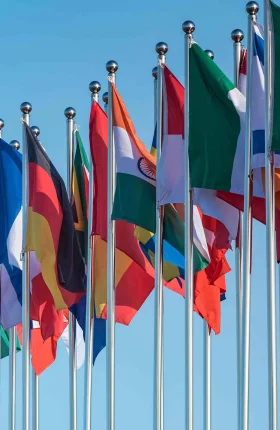Is globalization over? Some commentators consider the United Kingdom’s vote to leave the European Union to be a sign that it is. The decision—known as Brexit—is seen as reversing the trend toward greater global integration. Historically, globalization, or progressively closer global economic integration, has been driven by the tradeoff favoring global economics over local politics. This has resulted in the growth of foreign direct investment (FDI) and global trade, greater labor mobility, and ultimately higher economic growth around the world.
Brexit has certainly thrown markets, exchange rates, and consumer confidence into turmoil, but the model of globalization that has developed over the past 200 years started showing signs of change well before the referendum. For instance, the growth of global gross domestic product (GDP)—one of the traditional metrics of globalization—fell from a high of 6% in the 1960s to 3% in 2015. And FDI as a share of total investment has been declining even as total global investment has increased.
Most striking, there appears to be a structural delinking of trade (measured as the total imports and exports of goods and services), which is regarded as a hallmark of globalization, and GDP growth: from 1960 to 2008, the trade-to-GDP ratio grew by 35 percentage points; over the past five years, it has grown by only 0.2 points.
Experts from academia, the private sector, think tanks, and the media point to these indicators as evidence of the end of globalization. They also point to factors such as growing trade protectionism on one hand and the increasing cost of labor in emerging markets, which is leading to the reshoring of manufacturing, on the other. We, however, take a different view. We think that rather than signaling the death of globalization, the decline in the traditional metrics signals the birth of a radical new phase of globalization—one that rebalances geopolitics with geoeconomics.
To succeed in this new era, companies need to think about globalization in a different way, using different metrics, and devise a new framework to develop winning strategies. As Jeff Immelt, the CEO of GE, noted as he outlined the company’s new global strategy at an address to students in May 2016, “It is time for a bold pivot....in the face of a protectionist global environment....We will localize. In the future, sustainable growth will require a local capability inside a global footprint.”
The Old Model of Globalization
If we look at the growth of globalization in the modern era, beginning with the Industrial Revolution, we see that it has not been smooth but has instead progressed in distinct phases. The first one started in the early 1800s, triggered by the invention of the steam engine, which was followed by mass electrification across Western Europe. This phase was abruptly halted by the First World War.
The next phase began in the 1950s, with the introduction of mass manufacturing and the building of export supply chains into new markets, led by companies based in the United States. The oil crisis in the mid-1970s ended this phase. In the late 1980s, the third phase of globalization emerged as the internet allowed the outsourcing of low-cost manufacturing and services and the development of globally integrated supply chains. It ended with the onset of the financial crisis in 2008.
Although each phase was different from the previous one, all were based on the same model of globalization. This model consisted of three forces:
- A new technology that was leveraged by a country or a set of countries to boost productivity and output
- One or more countries serving as an economic “pole” (Western Europe, the US, and China, respectively, in each of the three phases) that became the global growth engine—driving 20% to 25% of GDP growth and around 15% of the growth in global trade—and that, in turn, fueled growth in other countries, especially trading partners
- A favorable system of global governance that facilitated cross-border financial and trade-led GDP growth through stable rules of the game
Together, these forces established a virtuous cycle of economic growth and greater global integration, thus ensuring that global economics continued to take precedence over local politics.
Breaking from the Past: The New Forces Shaping the Global Economy
We are now at the start of the fourth phase of globalization. To understand this, it is necessary to understand the new forces shaping the global economy.
The growth of digital is transforming global trade. Digital technologies are shaping global trade in three significant ways. First, they are altering productivity and competitiveness. By our estimation, the adoption of digital technology in manufacturing will increase output per worker by 30% and decrease labor costs by as much as 30% over the medium term in countries including South Korea, Germany, the US, and China. This means that companies will need to reconsider the decisions they made during the third phase of globalization about the location and design of their plants and supply chains. As the COO of a global industrial company told us, “Scale curves are flattening, and the cost advantage of low-cost labor evaporates if you calculate the total cost of ownership of shipping goods around the world from a low-cost factory.”
Adidas is already responding to these shifts: it recently announced that it is moving some of its production from China back to Germany because advances in robotics make it cost-effective to do so. In the medium term, Adidas plans to use this digital advantage to build factories in all major markets, thereby enabling faster delivery to customers.
As other companies follow suit, the shift will have a major effect on the trade of global goods—especially between developed economies and emerging markets, which was a hallmark of the third phase of globalization.
Second, while the trade in goods (which drove the earlier phases of globalization) is stagnating, the trade in global services—especially digitally enabled services—is growing. In 2014, services constituted 25% of total exports from OECD countries—up from 17% in 1980. This shift reflects the growing value of services in many industries, driven by the growth of digital technologies, which are blurring the boundary between products and services, as the leader of a global durables company told us. In aeronautics, the detection of problems in aircraft engines by remote digital sensing technology is transforming the economics of aircraft maintenance, reducing the need to station large teams of mechanics in all the airports a given aircraft visits.
Finally, the rapid growth of digital platforms has started to make national borders and traditional country-based business models redundant. Today, goods worth $700 billion are traded through Alibaba and Amazon—an amount that represents a compound annual growth rate of more than 33% since 2012.
In effect, these global market platforms and their associated supply and delivery systems are replacing the complex supply chains that were a common feature of the first three phases of globalization, making it much easier for even small companies to compete in a global market. For example, a Chinese mobile-phone company entered India by leveraging one such platform, and it did so more quickly and with much less investment than one of its competitors did just a few years earlier. The future could well include a proposal from Jack Ma, the founder of Alibaba, for a global e-commerce platform that would enable small and midsize enterprises to reach out to customers and source from suppliers all over the world, thereby eliminating the need to set up independent supply chains.
The impact of digital technologies means that the fourth phase of globalization will not look the same as the earlier phases. For a start, there will be no new economic pole, because digital technologies are not dominated by one country (or a few countries) that can leverage their benefits. And whereas in past phases new technologies supplanted the old, digital technologies will be unlikely to replace mass and low-cost manufacturing altogether—at least in the foreseeable future. This is not only because of the lack of skilled workers such as robot programmers but also because of the political need to protect jobs through the introduction of stringent regulations that will slow the adoption of new technologies.
But although digitization will not supplant old technologies, it will transform competitive rules and supply chains for companies; and it will affect industries such as logistics and international banks that have built significant businesses funding global trade.
The decentralization of global governance is changing the rules of the game. A stable set of rules and regulations, established and governed by the G7 group of leading economies, was central to the old model of globalization, facilitating the movement of goods and services around the world. Now, however, the value of openness is being questioned, even among the G7 countries—as shown by the Brexit poll.
The creation in 1999 of a G20, which incorporates the large emerging-market countries, signaled a seismic shift in the global economic power structure. These new members are not at the same stages of economic development as the G7 countries, and they have very different economic structures (for example, state domination of their financial systems and a majority of family-run businesses) and philosophies (for example, an emphasis on state regulations, as opposed to market efficiency, in policy design). This means that achieving consensus on economic policies and rules of engagement for global financial and trade flows is challenging and complex.
Along with the shift in the global governance role from the G7 to the G20, some structural shifts are leading to the decentralization of financial and trade institutions and the undermining of the common rules of the game. On the trade front, the free trade regime, as governed by the World Trade Organization, is changing, with the development of regional and subregional trade agreements such as the Trans-Pacific Partnership (TPP) and the Regional Comprehensive Economic Partnership (RCEP), which is under negotiation. Indeed, the number of active regional trade agreements has increased from 50 in 1995 to 280 today.
On the financial front, there are several newly powerful institutions dominated by China and some emerging-market countries, such as the Asian Infrastructure Investment Bank (AIIB) and the National Development Bank (NDB), each with a starting fund of $100 billion. The AIIB plans to lend $10 billion to $15 billion annually, an amount large enough to signal a shift in power away from institutions such as the Asian Development Bank, the World Bank, and the International Monetary Fund.
Moreover, the influence of individual governments on financial flows and competitive rules is increasing as a result of the direct acquisition of private companies, investments in sovereign wealth funds, and loans and subsidies for the development of high-priority domestic industries. The total value of sovereign wealth funds has more than doubled since 2008 (despite crashing oil prices), from $3 trillion to $7.2 trillion, and the share of state-owned enterprises (those in which governments have a majority stake) in the Fortune 500 increased from 9% in 2005 to 23% in 2014. Thus public capital has become as important as private capital.
The New Model of Globalization
For the past 200 years, globalization has been defined as the increasing integration of the rest of the world with Western countries through the flow of money, goods, services, and people. The twin forces of digitization and decentralization are tearing apart this old model of globalization. The market—and the opportunities—remain global, but the challenges are vastly more complex than ever before.
The familiar model of a single economic pole, a dominating technology, and a single system of governance is being replaced by a multipolar, diverse world. Companies will have to deal with a multiplicity of economies, governance organizations and rules, and technologies. Global integration will no longer occur only through physical highways. Instead, invisible data highways will be the new roads and shipping routes, and cloud storage will be the new shipping containers and warehouses.
In this new phase, growth will be less dependent on global trade. For emerging countries, growth will be determined more by internal structural reforms designed to drive domestic demand (rather than exports) and to broaden the industrial footprint (especially for commodity-producing countries). This is already happening in India, which is enjoying high rates of economic growth despite falling exports. For developed countries and China, growth will be driven primarily by improvements in productivity aided by new technology and innovation.
The globally optimized value chain—a familiar feature of the third phase of globalization—will give way to value chains that blend digital technology with older low-cost technologies, allow greater integration across products and services, and leverage the growth of independent global platforms for the exchange of goods and services.
And, perhaps most important, the emergence of a decentralized governance system will lead to the introduction of new rules that are more complex and volatile. These will include local and regional rules that strike a new balance between national political interests and global economic logic. These rules will be influenced by new institutions, such as the AIIB and the NDB, whose decisions are guided more by country and regional interests than by global concerns. The head of strategy of a multinational bank we spoke to called this the “Balkanization of the rules of the game.”
What CEOs Need to Do Now
The fourth phase of globalization will require companies to go beyond so-called glocalization—the incorporation of local nuances in a globally optimized business model—to an approach that is far more country centric. Companies building sustainable competitive advantage in this new era will require a radically different mindset and business model. To get started, CEOs should focus on five areas:
1. Strategic Framework. This should shift from one centered on a global headquarters and global optimization to one that delivers local maximization by taking a de-averaged country-by-country approach to making strategic choices. In selecting countries as potential markets, assessing a government’s ability to make internal structural reforms will be as important as assessing market size and income growth.
2. Corporate Mindset. CEOs will need to think in new ways so that they and their executive teams can deal with greater organizational complexity, diversity, and decentralization. In the new era, companies must, among other things, manage complex supply chains with multiple technology options and partner with governments and other distributors of state capital. They must be open to dealing with various regulatory philosophies and regimes. All this requires a new way of looking at the world.
3. Business Model. Companies will have to adopt asymmetric organizational models, structures, and processes that are specific to industries and countries and responsive to local rules and regulations. The large-scale, high-productivity logic of global optimization and standardization will no longer hold true—legal entities could vary widely across countries.
4. Risk Management. This will be an increasingly crucial function. In addition to traditional risk factors, such as natural disasters and financial or project risks, businesses will need to take into account more complex rules of the game as well as the rise of state capitalism and national interests. They must be prepared to vary risk strategies and appetites across markets.
5. Measuring Success. Companies will need to look beyond metrics that track growth in trade and foreign investments and develop metrics that track digital flows, the growth of global platforms, the ease of access to specialized skills, and the growth and reach of state capital. They will also need to balance traditional metrics that measure global optimization with country-centric metrics that measure their footprint and penetration across countries.
Globalization is not dead—but it is different. It is time to recognize this and take action. The winners in the fourth phase of globalization will be those who understand the forces of change and build businesses that can prosper in a multipolar world.






